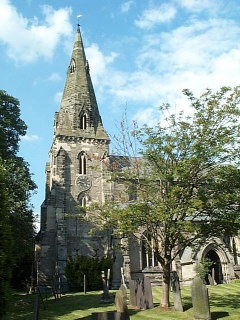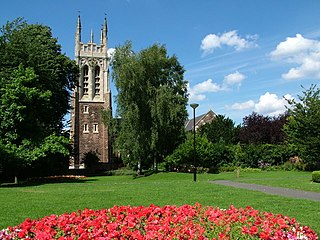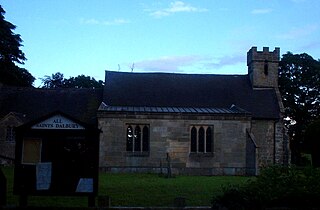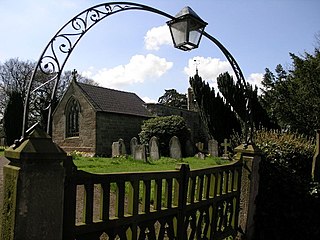History
The parish was historically part of a farm, with Burton Abbey records showing land ownership dating back to the early 12th century, when it was held by a man named Mabon. Mabon's grandson was known as Richard of Brizlincote. By the 14th century the land became known as the manor of Brizlincote and came into the Cuyly family, then by marriage to the Stanhope family. Sir Richard Stanhope sold the land to Robert Horton of Catton by the early 15th century. It remained with the Hortons until 1546 when it was sold to Sir William Paget. Paget sold the land in 1560 to a London merchant, John Merry. The Merry family retained ownership until 1708 when it was sold to Philip Stanhope, 2nd Earl of Chesterfield. [1]
Brizlincote Hall, now a farmhouse, was built in 1712 for the earl's son, Philip Stanhope, 3rd Earl of Chesterfield. The hall potentially occupies the site of the original medieval manor house, demolished in 1708. After the younger Phillip's death in 1726 the manor was let to tenant farmers. In the late 19th century the manor was passed to the Earls of Carnarvon. [1]
In 1878 Brizlincote, then part of Derbyshire, was added to the municipal borough of Burton upon Trent (which lay in Staffordshire). [2] The Local Government Act 1888 meant that the parts of the borough that lay in Derbyshire, including Brizlincote, were to be treated as if they were part of Staffordshire. The land was formally transferred to that county in 1894. Brizlincote Hall remains, now outside the parish, in Derbyshire. [3]
The Earls of Carnarvon sold the manor farm Brizlincote, comprising 253 acres (102 ha) in 1921 to William Lomas of King Sterndale. [1] The Lomas family retained ownership until the land was sold for housing development in the late 20th and early 21st centuries. Land in the parish was formerly farmland, as part of Holme Farm, Spring Cottage Farm, Tollgate Farm and the Model Dairy Farm. The land, also known as the Brizlincote Valley, was described locally as "Little Switzerland" for its charm and recreational use by townsfolk. [4] The Brizlincote Quarry extracted stone from a site between Brizlincote and Stapenhill. [5]
Brizlincote was one of seven parishes to be created when Burton was parished by East Staffordshire Borough Council in 2003. [6] The land forming the parish was formerly part of the areas of Stapenhill and Winshill, which are now parishes in their own right. [4]

Staffordshire is a landlocked county in the West Midlands region of England. It borders Cheshire to the northwest, Derbyshire and Leicestershire to the east, Warwickshire to the southeast, the West Midlands County and Worcestershire to the south and Shropshire to the west.

Bretby Hall is a country house at Bretby, Derbyshire, England, north of Swadlincote and east of Burton upon Trent on the border with Staffordshire. It is a Grade II listed building. The name Bretby means "dwelling place of Britons".

Bretby is a village and civil parish in the south of Derbyshire, England, north of Swadlincote and east of Burton upon Trent, on the border between Derbyshire and Staffordshire. The population of the civil parish as of the 2011 census was 893. The name means "dwelling place of Britons". On the A511 road, there is a secondary settlement, Stanhope Bretby, which was the site of Bretby Colliery.

Burton upon Trent, also known as Burton-on-Trent or simply Burton, is a market town in the borough of East Staffordshire in the county of Staffordshire, England, close to the border with Derbyshire. In 2011, it had a population of 72,299. The demonym for residents of the town is Burtonian. Burton is located 11 miles (18 km) south-west of Derby, 27 miles (43 km) north-west of Leicester, 28 miles (45 km) west-south-west of Nottingham and 20 miles (32 km) south of the southern entrance to the Peak District National Park.

Swadlincote is a former mining town in the district of South Derbyshire, England, lying within The National Forest area. It borders the counties of Leicestershire and Staffordshire, 5 miles (8 km) south-east of Burton upon Trent and north-west of Ashby-de-la-Zouch, and 11.5 miles (19 km) south-west of Derby. It also covers Newhall, Oversetts, Midway and the villages of Church Gresley and Woodville, with the sub-district of Goseley. It has a population of some 36,000. Castle Gresley is 2 miles (3 km) to the south-west and Albert Village 1.5 miles (2 km) to the south.

Willington is a village and civil parish in the South Derbyshire district of Derbyshire, England. The 2001 Census recorded a parish population of 2,604, increasing to 2,864 at the 2011 Census.

Austrey is a village and civil parish in the North Warwickshire District of Warwickshire, England. and the village lies at the northern extremity of the County.

Stapenhill is a suburban village and civil parish in Burton upon Trent, Staffordshire in the UK. It was a small village owned by Nigel of Stafford as far back as 1086, however, this ancient parish area has long since been surrounded by new housing developments and gradually absorbed into the Burton urban area. Stapenhill was known for its brickyards in the 18th and 19th centuries.
Winshill is an area to the east of the town of Burton upon Trent, in the borough of East Staffordshire, England.
Newton Solney is a small village and civil parish in South Derbyshire, England, located about two miles (3 km) from the East Staffordshire border, near to Burton upon Trent. The population of the civil parish as of the 2011 census was 659. Its nearest neighbour is Repton, situated about two miles (3 km) to the northeast.

Burton Abbey at Burton upon Trent in Staffordshire, England, was founded in the 7th or 9th century by St Modwen or Modwenna. It was refounded in 1003 as a Benedictine abbey by the thegn Wulfric Spott. He was known to have been buried in the abbey cloister in 1010, alongside the grave of his wife.

Dalbury Lees is a parish in south Derbyshire. The population of the civil parish as taken at the 2011 Census was 306. It is about six miles (10 km) from both Burton-on-Trent and Derby and just under four miles (6 km) from Egginton. The parish contains the villages of Dalbury and Lees which are just under 2 miles (3.2 km) apart from one another. Dalbury Lees has been known as Dalbury and as Dalbury with Lees, but Dalbury Lees is the preferred term

Edlaston is a village three miles south of Ashbourne in Derbyshire, just off the A515 road. It is in close proximity to the hamlet of Wyaston, and the civil parish is called Edlaston and Wyaston. It had a population of 220 at the 2011 Census.

St Mark's is the Church of England parish church for the Burton upon Trent suburb of Winshill, east of the town. It is part of the Diocese of Derby.

The Burton upon Trent and Swadlincote Green Belt is a green belt environmental and planning policy that regulates the rural space between the towns of Burton upon Trent and Swadlincote, in the counties of Derbyshire and Staffordshire, within the East Midlands region of England. Essentially, the function of the belt in this location is to prevent the towns merging by lessening urban sprawl. It is managed by local planning authorities on guidance from central government.

Stapenhill Gardens is a park in the Stapenhill neighbourhood of Burton-on-Trent, in England. It mainly comprises the former site of Stapenhill House, which was donated to the town in 1933, woodland, lawn, wild flower meadows and formal planted areas along a 1,250-metre (4,100 ft) stretch of the River Trent. A public space, it includes a large cement-rendered sculpture of a swan that has been described as a "Burton landmark".

Winshill Water Tower is a former water tower in Burton upon Trent, England. It was constructed in 1907 after a local resident won a High Court ruling against the South Staffordshire Waterworks Company for poor water-supply pressure. The brick tower held a cast-iron water tank at a height of 80 feet (24 m) to provide sufficient hydraulic head to improve water pressure. Constructed on Burton's highest point known as Waterloo Clump, the tower is visible from across the town and is a well known local landmark. The tower ceased to have any role in water supply in the 1990s but has since been used as a radio tower.

Sinai Park House is a grade II* listed building in Burton upon Trent, Staffordshire, England. Consisting of a central range with two wings the building is sited on a ridge of high ground near a chalybeate spring. The earliest remains of the site date to the 13th-century and it was occupied by the de Scobenhal family before being donated to Burton Abbey. The house was used as a place of convalescence for monks recovering from blood-letting procedures and its original name "seyney house" derived from the Old French "seyne" for blood. The estate was increased by enclosure and used as a hunting ground for the abbot. Much of the estate and house were let out by the early 16th century. The estate came into the hands of the Paget family after the Dissolution of the Monasteries. The Pagets used it for hunting and let out part of the estate to farmers. The house adopted its modern name of Sinai by the end of the 18th-century, a biblical reference.

Hoon is a civil parish within the South Derbyshire district, which is in the county of Derbyshire, England. It is a predominantly rural area with few residences or farms, Alongside with neighbouring Hatton village, it had a population of 2,785 residents in 2011. The parish is 110 miles (180 km) north west of London, 8 miles (13 km) south west of the county city of Derby, and 5 miles (8.0 km) north of the nearest market town of Burton-on-Trent in Staffordshire. It shares a border with the parishes of Church Broughton, Hatton, Hilton, Marston on Dove, Sutton on the Hill, as well as Tutbury.

















